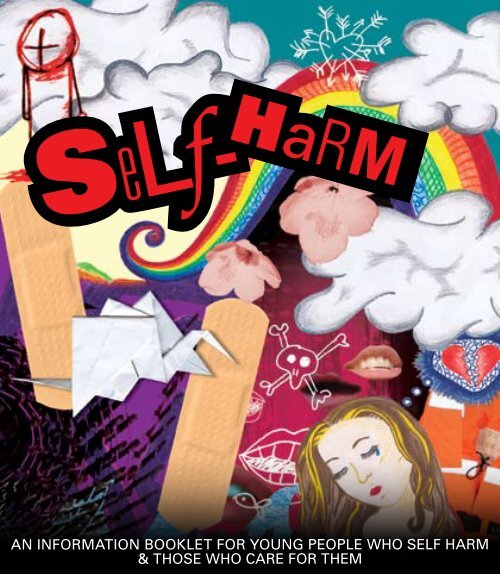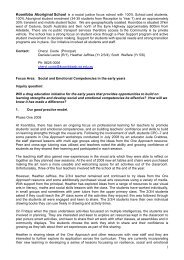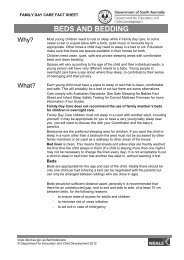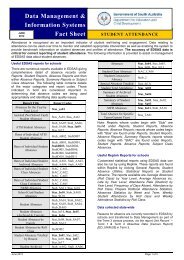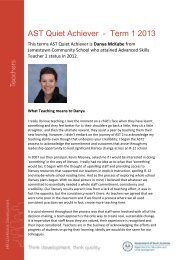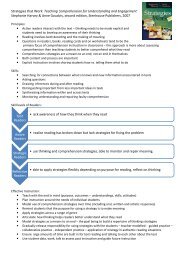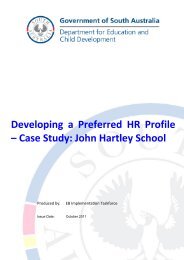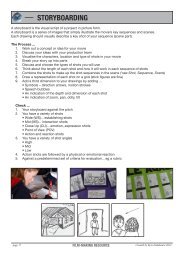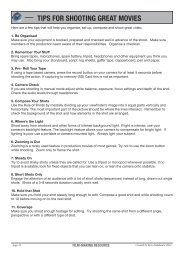an information booklet for young people who self harm & those who ...
an information booklet for young people who self harm & those who ...
an information booklet for young people who self harm & those who ...
Create successful ePaper yourself
Turn your PDF publications into a flip-book with our unique Google optimized e-Paper software.
SeLf-<br />
HaRM<br />
AN INFORMATION BOOKLET FOR YOUNG PEOPLE WHO SELF HARM<br />
& THOSE WHO CARE FOR THEM
Written &<br />
Compiled By<br />
Matt Strickl<strong>an</strong>d<br />
Psychologist<br />
Log<strong>an</strong>-Beaudesert Mental Health Service<br />
Queensl<strong>an</strong>d Health, 2006<br />
Artwork<br />
Graphic Design & Production by SpeakOut Ltd<br />
Artwork on front cover, back cover <strong>an</strong>d<br />
pages 10, 13, 14-15,18, & 20-21 by SERA
ACKNOWLEDGEMENTS &<br />
THANKS<br />
SELF HARM // An In<strong>for</strong>mation Booklet 3<br />
A big th<strong>an</strong>k you to following <strong>people</strong> <strong>who</strong> helped to make this <strong>booklet</strong> a reality:<br />
Clients of the Log<strong>an</strong>-Beaudesert Child <strong>an</strong>d Youth Mental Health Service<br />
<strong>an</strong>d Youth & Family Service, Log<strong>an</strong>, Prof. Graham Martin, University of<br />
Queensl<strong>an</strong>d, Youth & Family Service, Log<strong>an</strong>, Clinici<strong>an</strong>s from the Log<strong>an</strong>-<br />
Beaudesert Child & Youth Mental Health Service, Peter Kohleis, <strong>for</strong>mer<br />
Team Leader, Log<strong>an</strong>-Beaudesert Child <strong>an</strong>d Youth Mental Health Service,<br />
<strong>who</strong> encouraged <strong>an</strong>d supported this <strong>booklet</strong> to be available to <strong>young</strong><br />
<strong>people</strong> outside of this service, Dr Michael Daubney, Psychiatrist, Log<strong>an</strong>-<br />
Beaudesert Mental Health Service, Adam Lo <strong>an</strong>d Lidija Medosh, Young<br />
Persons Early Intervention Program, Log<strong>an</strong>-Beaudesert Mental Health<br />
Service, Anthony Radojevic, Writer, <strong>an</strong>d Teresa Fawcett, Log<strong>an</strong>-Beaudesert<br />
Health District Consumer Liaison Representative, Queensl<strong>an</strong>d Health.<br />
The content of this <strong>booklet</strong> has, in part, been compiled from the following<br />
sources:<br />
YOUNG ADULT HEALTH – www.cyh.com<br />
“COPING WITHOUT SELF-HARM – TREATMENT GUIDE FOR YOUNG<br />
PEOPLE” available from the Royal Australi<strong>an</strong> <strong>an</strong>d New Zeal<strong>an</strong>d College<br />
of Psychiatrists – www.r<strong>an</strong>zcp.org<br />
A RESEARCH PROPOSAL <strong>for</strong> “A r<strong>an</strong>domised trial of group therapy<br />
<strong>for</strong> deliberate <strong>self</strong> <strong>harm</strong> in adolescents” by Prof. Graham Martin, the<br />
University of Queensl<strong>an</strong>d <strong>an</strong>d Prof. Philip Hazell, University of Newcastle.<br />
Artwork © SpeakOut Limited 2006.<br />
Text © The State of Queensl<strong>an</strong>d (Queensl<strong>an</strong>d Health) 2006.<br />
Queensl<strong>an</strong>d Health permits third parties to adapt the text of this <strong>booklet</strong> to suit the needs<br />
of their own org<strong>an</strong>isation provided that:<br />
a) The use is non-commercial<br />
b) This copyright notice remains; <strong>an</strong>d<br />
c) Permission to adapt <strong>an</strong>d reprint the <strong>booklet</strong> <strong>an</strong>d artwork is obtained from<br />
SpeakOut Limited. Contact michael@speakout.com.au Phone: (07) 3493 7511.
SELF HARM // An In<strong>for</strong>mation Booklet 4<br />
SELF HARM<br />
– An In<strong>for</strong>mation Booklet For Young People Who Self<br />
Harm And Those Who Care For Them<br />
This <strong>booklet</strong> was put together in recognition that <strong>self</strong> <strong>harm</strong><br />
c<strong>an</strong> be one of the most challenging problems a <strong>young</strong><br />
person or the <strong>people</strong> <strong>who</strong> care <strong>for</strong> them have to face. We<br />
hope this <strong>booklet</strong> will give you some underst<strong>an</strong>ding of<br />
why you or someone you know hurts themselves. We<br />
also hope this <strong>booklet</strong> gives you ideas about ways to help<br />
someone <strong>who</strong> <strong>self</strong> <strong>harm</strong>s, or ways you might stop if you<br />
w<strong>an</strong>t to. Whether you are someone <strong>who</strong> <strong>self</strong> <strong>harm</strong>s or are<br />
caring <strong>for</strong> someone <strong>who</strong> does, always seek the assist<strong>an</strong>ce<br />
of a health professional where possible.
CONTENTS<br />
1. GENERAL IMFORMATION 6<br />
2. WHAT IS SELF HARMING? 8<br />
SELF HARM // An In<strong>for</strong>mation Booklet 5<br />
3. WHY DO PEOPLE SELF HARM? 10<br />
4. WHY DO PEOPLE KEEP DOING IT? 14<br />
5. SOME STUFF TO THINK ABOUT 16<br />
6. HOW CAN I STOP SELF HARMING? 18<br />
7. WHY IS IT SO HARD TO TALK ABOUT? 22<br />
8. HOW CAN I HELP? 24<br />
9. LOOKING FORWARD 28<br />
10. WHERE TO GO FOR HELP 30<br />
11. REFERENCES 32<br />
12. MY PLAN TO STOP SELF HARMING 35
SELF HARM // An In<strong>for</strong>mation Booklet 6<br />
1. GENERAL<br />
INFORMATION<br />
Being someone <strong>who</strong> <strong>self</strong> <strong>harm</strong>s or being close to someone<br />
<strong>who</strong> <strong>self</strong> <strong>harm</strong>s is tough. Underst<strong>an</strong>ding why someone<br />
close to you hurts themselves c<strong>an</strong> be very difficult, even<br />
scary. People have all sorts of feelings about <strong>self</strong> <strong>harm</strong><br />
including fear, <strong>an</strong>ger, frustration, helplessness <strong>an</strong>d worry.<br />
Self <strong>harm</strong> is a common health problem <strong>for</strong> <strong>young</strong> <strong>people</strong>.<br />
About 25,000 Australi<strong>an</strong>s are admitted to hospital each<br />
year because of <strong>self</strong> <strong>harm</strong>. Two out if three emergency<br />
appointments to child <strong>an</strong>d youth health services are<br />
because of <strong>self</strong> <strong>harm</strong>. For every teenager <strong>who</strong> goes to one<br />
of these services, there are nine others in the community<br />
<strong>who</strong> have <strong>self</strong> <strong>harm</strong>ed. Adults <strong>who</strong> <strong>self</strong> <strong>harm</strong> are 100<br />
times more likely to suicide.<br />
“SELF HARM IS A COMMON HEALTH PROBLEM FOR<br />
YOUNG PEOPLE.”<br />
Between 1 to 4% of <strong>young</strong> males <strong>an</strong>d 1 to 10% of <strong>young</strong><br />
females will <strong>self</strong> <strong>harm</strong>. The most frequent types of<br />
<strong>self</strong> <strong>harm</strong> in teenagers include cutting, overdosing <strong>an</strong>d<br />
poisoning <strong>an</strong>d to a lesser degree, head b<strong>an</strong>ging, burning,<br />
str<strong>an</strong>gling themselves <strong>an</strong>d jumping from heights.<br />
Poisoning <strong>an</strong>d overdosing are the behaviours most likely<br />
to attract medical attention, although cutting is the most<br />
common <strong>for</strong>m of <strong>self</strong> <strong>harm</strong> in <strong>young</strong> <strong>people</strong>.
People <strong>self</strong> <strong>harm</strong> <strong>for</strong> different reasons although it is<br />
usually linked to <strong>an</strong>xiety, depression <strong>an</strong>d <strong>an</strong>ger. Self<br />
<strong>harm</strong>ing does not always me<strong>an</strong> that you w<strong>an</strong>t to commit<br />
suicide, that you are “looking <strong>for</strong> attention” or you are<br />
being m<strong>an</strong>ipulative.<br />
Young <strong>people</strong> <strong>who</strong> <strong>self</strong> <strong>harm</strong> do so as a way to cope with<br />
emotions <strong>an</strong>d situations they feel are too hard to deal<br />
with. Some <strong>young</strong> <strong>people</strong> don’t know how to put this pain<br />
into words <strong>an</strong>d <strong>self</strong> <strong>harm</strong> is the only way to show others<br />
the hurt inside. For someone to hurt them<strong>self</strong> by cutting<br />
or burning their body, they must be suffering a lot.<br />
FOR SOMEONE TO HURT THEMSELF BY CUTTING<br />
OR BURNING THEIR BODY, THEY MUST BE<br />
SUFFERING A LOT.<br />
SELF HARM // An In<strong>for</strong>mation Booklet 7
SELF HARM // An In<strong>for</strong>mation Booklet 8<br />
2. WHAT IS SELF<br />
HARMING?<br />
Self <strong>harm</strong>ing has different names. Some of these are:<br />
CUTTING<br />
SELF-MUTILATION<br />
SELF-INFLICTED VIOLENCE<br />
PARASUICIDE<br />
SELF-ABUSE<br />
Just as <strong>self</strong> <strong>harm</strong>ing has lots of different names it also has<br />
lots of definitions. One way of defining <strong>self</strong> <strong>harm</strong> is:<br />
WHEN SOMEONE DELIBERATELY HURTS<br />
THEMSELVES WITHOUT WANTING TO KILL<br />
THEMSELVES.
Most <strong>people</strong> would think of cutting when they think of <strong>self</strong><br />
<strong>harm</strong>ing. The reality is that there are lots of behaviours<br />
that are <strong>self</strong> <strong>harm</strong>. Some of these are:<br />
CUTTING WITH RAZORS, KNIVES OR SHARP OBJECTS<br />
TAKING AN OVERDOSE OF MEDICATION OR DRINKING POISON<br />
BURNING YOURSELF<br />
SCRATCHING WHICH RESULTS IN BLEEDING OR WELTS<br />
PICKING AT SKIN<br />
PULLING HAIR<br />
HITTING YOURSELF WITH YOUR FISTS OR SOMETHING ELSE<br />
PUNCHING WALLS OR OBJECTS TO HURT YOURSELF<br />
If you are not sure whether you are <strong>self</strong> <strong>harm</strong>ing or if you are<br />
worried about someone else’s behaviour, here are some<br />
questions you might w<strong>an</strong>t to ask:<br />
DO YOU deliberately hurt your<strong>self</strong> in a way which<br />
breaks the skin, leaves marks that last <strong>for</strong> a while or<br />
scars you?<br />
DO YOU deliberately do things to your<strong>self</strong> which you<br />
should go to the doctor <strong>for</strong>?<br />
DO YOU hurt your<strong>self</strong> as a way of getting rid of<br />
horrible feelings, dealing with difficult situations or<br />
because you feel numb?<br />
SELF HARM // An In<strong>for</strong>mation Booklet 9<br />
These are questions you might like to think about. If you<br />
w<strong>an</strong>t some real <strong>an</strong>swers, the best thing to do is talk to a<br />
health professional or someone you trust.
SELF HARM // An In<strong>for</strong>mation Booklet 10<br />
3. WH DO PEOPLE<br />
SELF HARM?<br />
People hurt them<strong>self</strong> because it is the only thing they<br />
c<strong>an</strong> think of doing to cope. Self <strong>harm</strong>ing c<strong>an</strong> be a way of<br />
dealing with feelings of sadness, depression, guilt,<br />
<strong>an</strong>ger, hate, fear, <strong>an</strong>xiousness, low <strong>self</strong> esteem,<br />
loneliness, shame, <strong>an</strong>d numbness.
Some reasons <strong>people</strong> <strong>self</strong> <strong>harm</strong> include:<br />
FEELING UPSET, ANGRY OR SCARED <strong>an</strong>d the only<br />
way to stop these feelings is by hurting themselves<br />
HAVING A HORRIBLE FEELING building up inside <strong>an</strong>d<br />
cutting is the only way to let it out<br />
FEELING ALONE AND ISOLATED from everybody <strong>an</strong>d<br />
hurting themselves is the only way they feel ‘real’ or<br />
‘connected’<br />
FEELING OUT OF CONTROL <strong>an</strong>d cutting or hurting<br />
themselves is the only way they feel in control<br />
FEELING RESPONSIBLE <strong>for</strong> everything <strong>an</strong>d everyone<br />
FEELING NUMB <strong>an</strong>d the only way they feel is by<br />
causing pain<br />
IT CAN MAKE THE PAIN YOU FEEL INSIDE visible <strong>an</strong>d<br />
when it is visible, it’s easier to underst<strong>an</strong>d<br />
FEELING LIKE others only care about them if<br />
something bad happens<br />
FEELING LIKE everything is hopeless<br />
SELF HARMING c<strong>an</strong> be a way of punishing them –<br />
selves or others <strong>for</strong> something<br />
FEELING BAD about themselves <strong>an</strong>d<br />
FEELING LIKE they have no one to talk to.<br />
SELF HARM // An In<strong>for</strong>mation Booklet 11
SELF HARM // An In<strong>for</strong>mation Booklet 12<br />
PEOPLE HURT THEMSELVES BECAUSE IT IS THE<br />
ONLY THING THEY CAN THINK OF DOING TO COPE.<br />
Some <strong>people</strong> <strong>who</strong> <strong>self</strong> <strong>harm</strong> have experienced physical<br />
abuse or suffer from <strong>an</strong>xiety. Other <strong>people</strong> have<br />
experienced sexual or emotional abuse, lost a family<br />
member or were not treated well as a child. This c<strong>an</strong><br />
create stress <strong>an</strong>d pain in <strong>people</strong>’s lives. Sometimes this<br />
leads <strong>people</strong> to stop the pain by hurting themselves.<br />
However, not all <strong>people</strong> that <strong>self</strong> <strong>harm</strong> have been<br />
abused or experienced big losses.<br />
People <strong>who</strong> <strong>self</strong> <strong>harm</strong> have difficulty coping with <strong>an</strong>d<br />
talking about their emotions. Because of this, these<br />
emotions c<strong>an</strong> build up <strong>an</strong>d feel too much. Self <strong>harm</strong><br />
c<strong>an</strong> seem like the only thing that will make these<br />
emotions go away or to feel something different.<br />
People <strong>who</strong> <strong>self</strong> <strong>harm</strong> may not like themselves or their<br />
bodies. They may have difficulties with relationships,<br />
not be able to talk about what is going on or be<br />
depressed, <strong>an</strong>xious or stressed. It is import<strong>an</strong>t to<br />
underst<strong>an</strong>d that whatever the reason you <strong>self</strong> <strong>harm</strong>,<br />
there are other ways of dealing with the way you feel.
SELF HARM // An In<strong>for</strong>mation Booklet 13
SELF HARM // An In<strong>for</strong>mation Booklet 14<br />
4. WHY DO PEOPLE<br />
K P DOING IT?<br />
EE<br />
Some <strong>people</strong> say that <strong>self</strong> <strong>harm</strong> helps take away the<br />
emotional pain <strong>an</strong>d that this seems like the only way.<br />
If something makes us feel better, then we tend to keep<br />
doing it. In this way, <strong>self</strong> <strong>harm</strong>ing is like <strong>an</strong> ADDICTIVE<br />
BEHAVIOUR. Like a drug, <strong>self</strong> <strong>harm</strong>ing when you feel like<br />
you are not coping c<strong>an</strong> make you feel better. Because you<br />
feel better, you keep doing it.<br />
Something that is addictive is really hard to give up.<br />
When <strong>people</strong> find hurting themselves brings relief, it c<strong>an</strong><br />
become their main way of dealing with problems – this<br />
c<strong>an</strong> start to affect their life in a negative way. What is<br />
import<strong>an</strong>t to underst<strong>an</strong>d is that SELF HARMING IS JUST<br />
ONE WAY OF DEALING WITH THINGS <strong>an</strong>d that THERE ARE<br />
OTHER WAYS!
Some other reasons why <strong>people</strong> find it difficult to stop <strong>self</strong><br />
<strong>harm</strong>ing include:<br />
WONDERING WHAT THEY WILL DO to cope instead<br />
of <strong>self</strong> <strong>harm</strong>ing<br />
WONDERING WHETHER PEOPLE will still show they<br />
care if they don’t see the cuts <strong>an</strong>d scars<br />
WONDERING WHETHER PEOPLE will still know that<br />
they are hurting if they don’t see <strong>an</strong>y injuries<br />
LETTING GO OF SELF HARMING is like letting go of a<br />
familiar part of your<strong>self</strong> “Who will I be if I don’t <strong>self</strong><br />
<strong>harm</strong>?”<br />
WORRYING THAT THEY MIGHT get swallowed up by<br />
their feelings if they don’t <strong>self</strong> <strong>harm</strong><br />
CONCERNED that they might stay numb.<br />
SELF HARM // An In<strong>for</strong>mation Booklet 15
SELF HARM // An In<strong>for</strong>mation Booklet 16<br />
5. SOME STUFF TO<br />
THINK ABOUT<br />
You may be <strong>self</strong> <strong>harm</strong>ing <strong>an</strong>d not be able to see<br />
the negative effects. Here are some consequences<br />
of <strong>self</strong> <strong>harm</strong>ing:<br />
YOU MAY ACCIDENTALLY OR DELIBERATELY GO<br />
TOO FAR ONE DAY AND CAUSE YOURSELF A<br />
SEVERE INJURY OR SUICIDE.<br />
CUTS SOMETIMES TURN INTO SCARS: Most <strong>people</strong><br />
don’t underst<strong>an</strong>d <strong>self</strong> <strong>harm</strong> <strong>an</strong>d may treat you<br />
differently when they see your scars. This c<strong>an</strong> make it<br />
difficult to make friends, get a job, have a boyfriend/<br />
girlfriend or wear t-shirts without <strong>people</strong> seeing your<br />
injuries. Having said this, <strong>those</strong> <strong>people</strong> <strong>who</strong> only<br />
judge you by your scars don’t know the real you.<br />
PEOPLE WHO SELF HARM USUALLY KEEP IT A<br />
SECRET: This c<strong>an</strong> be a really lonely experience.<br />
Dealing with your feelings in this way me<strong>an</strong>s you are<br />
probably not sharing your pain or getting the support<br />
you need.
YOU MAY BE AVOIDING THE ISSUES THAT LEAD TO<br />
YOU SELF HARMING: Expressing your<strong>self</strong> in this way<br />
might not allow you to see the causes of your pain.<br />
YOU MAY HAVE TO LIE: You may have to lie to friends<br />
<strong>an</strong>d others about your injuries. Most <strong>young</strong> <strong>people</strong><br />
find this difficult <strong>an</strong>d stressful. As a result of the lie,<br />
you may think, “Do they believe me?”, “Do they think<br />
I’m a freak?”<br />
YOU MAY FEEL GUILTY: Young <strong>people</strong> <strong>who</strong> <strong>self</strong> <strong>harm</strong><br />
often feel guilty about it. This me<strong>an</strong>s that they hide<br />
their behaviour <strong>an</strong>d get down on themselves. This<br />
creates more stress <strong>an</strong>d hurt which leads to more <strong>self</strong><br />
<strong>harm</strong> to cope.<br />
SELF HARM // An In<strong>for</strong>mation Booklet 17
SELF HARM // An In<strong>for</strong>mation Booklet 18<br />
6. HOW CAN I STOP<br />
SELF HARMING?<br />
Self <strong>harm</strong> is a way of trying to cope with inner pain. It is<br />
very difficult to stop <strong>self</strong> <strong>harm</strong>ing without having other<br />
ways to cope. Ch<strong>an</strong>ging <strong>an</strong>y behaviour is difficult <strong>an</strong>d it is<br />
a decision ONLY YOU c<strong>an</strong> make. Here are some different<br />
ways you c<strong>an</strong> react when you feel like <strong>self</strong> <strong>harm</strong>ing.<br />
These won’t always be easy <strong>an</strong>d will take lots of ef<strong>for</strong>t.
DECIDE that you w<strong>an</strong>t to stop <strong>self</strong> <strong>harm</strong>ing – making<br />
this decision is the first step.<br />
TAKE YOURSELF AWAY from the situation – something<br />
as simple as removing your<strong>self</strong> from the<br />
presence of knives, razors or whatever it is you use to<br />
<strong>self</strong> <strong>harm</strong> works <strong>for</strong> some <strong>people</strong>.<br />
15 MINUTE DELAY – try not to <strong>self</strong> <strong>harm</strong> <strong>for</strong> 15<br />
minutes. If this works, try <strong>an</strong>other 15 minutes <strong>an</strong>d so<br />
on.<br />
HAVE SOMETHING TO DO – keeping your<strong>self</strong><br />
occupied c<strong>an</strong> keep your mind off stress <strong>an</strong>d not leave<br />
you time to think about <strong>self</strong> <strong>harm</strong>ing. Pl<strong>an</strong> things to<br />
do to occupy your free time. You could paint, listen<br />
to music, draw, play guitar, d<strong>an</strong>ce, write, sing or<br />
<strong>an</strong>ything creative.<br />
SELF HARM // An In<strong>for</strong>mation Booklet 19<br />
TRY TO FOCUS on something else rather th<strong>an</strong> the pain<br />
you may be feeling. You could go outside <strong>an</strong>d look<br />
at the clouds, take a shower, watch some TV, read a<br />
book, go <strong>for</strong> a run, get on the internet, eat some food,<br />
drink a hot drink etc. Anything that distracts you from<br />
how you might be feeling c<strong>an</strong> stop you feeling worse.
SELF HARM // An In<strong>for</strong>mation Booklet 20<br />
MAKE A LIST OF FRIENDS/SUPPORTS you c<strong>an</strong> talk<br />
to or call when you feel you need to. These <strong>people</strong><br />
should underst<strong>an</strong>d your situation <strong>an</strong>d what you’re<br />
going through. Not all friends will be able to do<br />
this – most <strong>people</strong> find it difficult to underst<strong>an</strong>d<br />
why someone <strong>self</strong> <strong>harm</strong>s. If your friends are having<br />
trouble underst<strong>an</strong>ding you may need to talk to a<br />
professional (see details on page 30 & 31 of this<br />
<strong>booklet</strong>).<br />
TRY DEEP BREATHING <strong>an</strong>d relaxation exercises.<br />
Deep breathing provides your body with oxygen<br />
which c<strong>an</strong> help you feel relaxed. Deep breathing <strong>an</strong>d<br />
relaxation exercises c<strong>an</strong> also be good ways to stop<br />
you focussing on your emotions.<br />
WRITE A DIARY – write down how you feel <strong>an</strong>d what<br />
might have made you feel like you w<strong>an</strong>ted to <strong>self</strong><br />
<strong>harm</strong>. In this way you c<strong>an</strong> be aware of what leads to<br />
you <strong>self</strong> <strong>harm</strong>ing <strong>an</strong>d what you might be able to do<br />
be<strong>for</strong>e things gets too bad.
MAKE A LIST OF REASONS why you are going to stop<br />
hurting your<strong>self</strong> <strong>an</strong>d set some realistic goals to help<br />
stop <strong>self</strong> <strong>harm</strong>ing e.g. “Next time I feel like cutting,<br />
I will scream into my pillow”.<br />
CALL A CRISIS LINE if you feel that your <strong>self</strong> <strong>harm</strong> is<br />
becoming d<strong>an</strong>gerous. See the list of helpful numbers<br />
on pages 30 & 31.<br />
If you’re trying to stop, it’s import<strong>an</strong>t to underst<strong>an</strong>d that<br />
you may do it again. Don’t get down on your<strong>self</strong> about<br />
this. What’s import<strong>an</strong>t is that you don’t give up trying<br />
to stop <strong>an</strong>d you get the support you need to help you<br />
through.<br />
“TRY TO FOCUS ON SOMETHING ELSE RATHER<br />
THAN THE PAIN YOU MAY BE FEELING.”<br />
SELF HARM // An In<strong>for</strong>mation Booklet 21
SELF HARM // An In<strong>for</strong>mation Booklet 22<br />
7. WHY IS IT SO HARD<br />
TO TALK ABOUT?<br />
Talking to <strong>people</strong> that you are close to about <strong>self</strong> <strong>harm</strong><br />
c<strong>an</strong> be really hard. A lot of <strong>young</strong> <strong>people</strong> <strong>who</strong> <strong>self</strong> <strong>harm</strong><br />
worry about how their family <strong>an</strong>d friends will react. Some<br />
likely reactions are:<br />
•<br />
•<br />
•<br />
•<br />
•<br />
•<br />
•<br />
BEING VERY WORRIED ABOUT YOU AND BECOMING UPSET<br />
NOT KNOWING WHAT TO DO OR SAY<br />
GETTING ANGRY BECAUSE THEY DON’T UNDERSTAND<br />
FEELING LIKE IT MIGHT BE THEIR FAULT<br />
TELLING YOU NOT TO DO IT AGAIN OR TELLING YOU TO<br />
STOP BEING SILLY<br />
TRYING TO IGNORE IT IN THE HOPE IT WILL STOP<br />
THINKING THAT YOU ARE DOING IT FOR ATTENTION<br />
Whatever you think the reaction might be, it is import<strong>an</strong>t you<br />
talk to someone about your <strong>self</strong> <strong>harm</strong>ing. Keeping it a secret will<br />
only keep the behaviour going <strong>an</strong>d you will be at risk of seriously<br />
injuring your<strong>self</strong> or worse.<br />
Here are some ways of getting support from others:<br />
BE SENSITIVE to <strong>those</strong> around you. Self <strong>harm</strong>ing<br />
may seem like a normal behaviour to you but to<br />
the <strong>people</strong> around you it may seem frightening.
When you talk to <strong>people</strong> about it, try to PICK A PLACE<br />
THAT IS PRIVATE where you c<strong>an</strong> talk about it without<br />
pressure.<br />
Make sure you <strong>an</strong>d the other person have TIME TO<br />
TALK ABOUT IT – try not to mention it on your way<br />
out the door.<br />
Tell the person THE THINGS YOU ARE DOING TO<br />
TRY AND STOP HARMING YOURSELF.<br />
“WHATEVER YOU THINK THE REACTION MIGHT<br />
BE, IT IS IMPORTANT YOU TALK TO SOMEONE<br />
ABOUT YOUR SELF HARMING.”<br />
SELF HARM // An In<strong>for</strong>mation Booklet 23<br />
It is never going to be easy talking with other <strong>people</strong> about<br />
your <strong>self</strong> <strong>harm</strong>. Remember, you are in control of how <strong>an</strong>d<br />
what they find out.
SELF HARM // An In<strong>for</strong>mation Booklet 24<br />
8. HOW CAN I HELP?<br />
Finding out that someone you care about is hurting<br />
them<strong>self</strong> is tough. M<strong>an</strong>y <strong>people</strong> c<strong>an</strong>’t underst<strong>an</strong>d why<br />
someone would w<strong>an</strong>t to hurt themselves. It’s hard not to<br />
take it personally <strong>an</strong>d w<strong>an</strong>t to convince the person to stop.
Here are some tips <strong>for</strong> helping someone <strong>who</strong> <strong>self</strong><br />
<strong>harm</strong>s:<br />
SEEK SUPPORT OF A HEALTH PROFESSIONAL – Self<br />
<strong>harm</strong> is a complex behaviour that may go on <strong>for</strong> a<br />
long time. It is import<strong>an</strong>t that you have the support<br />
<strong>an</strong>d advice of a health professional.<br />
DON’T TAKE IT PERSONALLY – When <strong>people</strong> <strong>self</strong><br />
<strong>harm</strong>, they don’t do it to intentionally make you feel<br />
bad or guilty. Even if it feels like they are trying to<br />
m<strong>an</strong>ipulate you, that may not be the reason they <strong>self</strong><br />
<strong>harm</strong>.<br />
MAKE A PLAN – If you’re able to, sit down with the<br />
<strong>young</strong> person <strong>an</strong>d make a pl<strong>an</strong> about what to do if<br />
they feel like <strong>self</strong> <strong>harm</strong>ing or has <strong>self</strong> <strong>harm</strong>ed. This<br />
might make things feel safer <strong>for</strong> you <strong>an</strong>d the <strong>young</strong><br />
person. This may also reduce the ‘secrecy’ around<br />
the <strong>self</strong> <strong>harm</strong>ing <strong>an</strong>d make the <strong>young</strong> person feel<br />
supported. If in doubt, talk to a health professional.<br />
BE SUPPORTIVE AND REMAIN CALM – Often, <strong>people</strong><br />
react by making a big fuss about the <strong>self</strong> <strong>harm</strong> <strong>an</strong>d<br />
become upset, <strong>an</strong>gry or both. This may make the<br />
situation worse as the <strong>young</strong> person is already trying<br />
to cope with their own emotions. They may then <strong>self</strong><br />
<strong>harm</strong> in secret because they fear your reaction.<br />
SELF HARM // An In<strong>for</strong>mation Booklet 25
SELF HARM // An In<strong>for</strong>mation Booklet 26<br />
In a calm voice, ask the <strong>young</strong> person if they w<strong>an</strong>t to<br />
talk – this leaves the control in their h<strong>an</strong>ds about this.<br />
Make the initial approach but don’t push them.<br />
Being supportive doesn’t me<strong>an</strong> you’re saying the<br />
behaviour is OK – it’s saying that you w<strong>an</strong>t to be there<br />
<strong>for</strong> the <strong>young</strong> person to help them. You might start<br />
by saying, “People hurt themselves when they are<br />
feeling bad. Do you w<strong>an</strong>t to talk to me about it?”<br />
“ANYTHING THAT DISTRACTS YOU FROM HOW<br />
YOU MIGHT BE FEELING CAN STOP YOU FEELING<br />
WORSE.”<br />
DON’T TAKE IT PERSONALLY... TRY TO REMAIN<br />
CALM (AND) UNDERSTAND WHY THE YOUNG<br />
PERSON IS SELF HARMING.
DON’T TELL THEM NOT TO DO IT: A normal reaction<br />
to <strong>self</strong> <strong>harm</strong> is to tell the person not to do it or that<br />
it makes you feel bad. This often leads to the <strong>young</strong><br />
person feeling guilty <strong>an</strong>d they may start to hide their<br />
<strong>self</strong> <strong>harm</strong> so you don’t feel this way.<br />
TAKE CARE OF YOURSELF – This is really difficult!<br />
You will need time to adjust. Make sure you are<br />
taking care of your own needs, as well as <strong>those</strong> of<br />
the person you care about. The more you are able to<br />
relax, the easier it will be to deal with the <strong>self</strong> <strong>harm</strong>.<br />
BE CLEAR ABOUT WHAT YOUR LIMITS ARE – Most<br />
<strong>people</strong> feel completely out of their depth when it<br />
comes to <strong>self</strong> <strong>harm</strong>. It’s OK if you feel uncom<strong>for</strong>table<br />
with it <strong>an</strong>d it’s ok if you don’t feel able to talk about<br />
it. Let the <strong>young</strong> person know this <strong>an</strong>d together seek<br />
out the assist<strong>an</strong>ce of a health professional such as a<br />
psychologist, psychiatrist or counsellor (page 30-31).<br />
TRY TO UNDERSTAND WHY THE YOUNG PERSON<br />
IS SELF HARMING – Some <strong>people</strong> feel sick at<br />
the thought that someone they know is <strong>harm</strong>ing<br />
themselves. Try to underst<strong>an</strong>d what the<br />
issues behind the <strong>self</strong> <strong>harm</strong> are <strong>an</strong>d<br />
how you c<strong>an</strong> support that <strong>young</strong><br />
person to find different ways of<br />
coping.<br />
SELF HARM // An In<strong>for</strong>mation Booklet 27
SELF HARM // An In<strong>for</strong>mation Booklet 28
9. LOOKING FORWARD<br />
When everything seems too big to h<strong>an</strong>dle <strong>an</strong>d you c<strong>an</strong>’t<br />
see a way out, it c<strong>an</strong> be hard to think about your future.<br />
When you feel this way there are some things you c<strong>an</strong><br />
think about:<br />
THE PEOPLE that you most look up to have probably<br />
gone through a really difficult time in their life – it<br />
does end.<br />
THE PROBLEMS that seem unsolvable will ch<strong>an</strong>ge.<br />
LIFE is always ch<strong>an</strong>ging.<br />
FEELING BAD doesn’t last <strong>for</strong>ever – it only lasts as<br />
long as we think about it.<br />
IF YOU WENT to live on the Moon, there would be at<br />
least one person <strong>who</strong> would be sad to see you go.<br />
SELF HARM // An In<strong>for</strong>mation Booklet 29<br />
There are <strong>people</strong> <strong>who</strong> w<strong>an</strong>t to hear what you’ve got to say.<br />
There are <strong>people</strong> <strong>who</strong> underst<strong>an</strong>d. There are <strong>people</strong> <strong>who</strong><br />
w<strong>an</strong>t to help you stop <strong>self</strong> <strong>harm</strong>ing. Self <strong>harm</strong>ing stops<br />
you from dealing with the reasons <strong>for</strong> your pain. There<br />
are other ways to deal with how you feel that don’t cause<br />
<strong>harm</strong> to your<strong>self</strong>. The first step is to reach out <strong>an</strong>d talk to<br />
someone <strong>an</strong>d see the future you have ahead of you.
SELF HARM // An In<strong>for</strong>mation Booklet 30<br />
10. RESOURCES<br />
KIDS HELP LINE<br />
Phone: 1800 551 800<br />
LIFELINE AUSTRALIA<br />
Phone: 131 114<br />
FAMILIES SA - CRISIS CARE<br />
SERVICE Phone: 131 611<br />
YOUR GENERAL PRACTITIONER (Doctor)<br />
YOUR SCHOOL COUNSELLOR<br />
YOUR LOCAL COMMUNITY OR YOUTH (HEALTH)<br />
SERVICE<br />
YOUR LOCAL CHILD AND ADOLESCENT MENTAL<br />
HEALTH SERVICE (CAMHS)<br />
YOUR LOCAL FAMILIES SA SERVICE<br />
THE EMERGENCY DEPARTMENT OF YOUR LOCAL<br />
HOSPITAL<br />
CHILDREN YOUTH AND WOMEN’S HEALTH<br />
SERVICE AFTER HOURS MENTAL HEALTH SERVICE<br />
Phone: 8161 8151<br />
ASSESSMENT & CRISIS INTERVENTION SERVICE<br />
(Adults) (ACIS)<br />
For <strong>young</strong> <strong>people</strong> over the age of 18 years<br />
Phone: 131 465
SANE AUSTRALIA Mental Illness Help Line<br />
Monday – Friday 9am – 5pm<br />
Phone: 1800 688 382<br />
www.s<strong>an</strong>e.org<br />
YOUNG ADULT HEALTH TOPICS<br />
www.cyh.com<br />
www.headroom.net.au<br />
www.reachout.com.au<br />
www.kidsmind.org.au<br />
SELF HARM // An In<strong>for</strong>mation Booklet 31
SELF HARM // An In<strong>for</strong>mation Booklet 32<br />
11. REFERENCES<br />
FAVAZZA, A. R. (1998). \\ The Coming of Age of Self<br />
Mutilation. The Journal of Nervous <strong>an</strong>d Mental Disease.<br />
\\ 186(5): 259-268.<br />
BRENT, D.A. (1997). \\ The aftercare of adolescents<br />
with deliberate <strong>self</strong> <strong>harm</strong>. Journal of Child Psychology<br />
<strong>an</strong>d Psychiatry <strong>an</strong>d Allied Disciplines. \\ 38: 277-286.<br />
HAINES, J. & WILLIAMS, C. (1997). \\ Coping <strong>an</strong>d<br />
problem solving of <strong>self</strong> mutilators. Journal of Clinical<br />
Psychology. \\ 53(2): 177-186.<br />
HAWTON K., ARENSMAN E., TOWNSEND E.,<br />
BREMNER S., FELDMAN E., GOLDNEY R., GUNNELL<br />
D., HAZELL P., VAN HEERINGEN K., HOUSE A.,<br />
OWENS D., SAKINOFSKY I. & TRASKMAN-BENDZ L.<br />
(1998). \\ Deliberate <strong>self</strong>-<strong>harm</strong>: A systematic review<br />
of the efficacy of psychosocial <strong>an</strong>d p<strong>harm</strong>acological<br />
treatments in preventing repetition. British Medical<br />
Journal. \\ 317: 441-447.<br />
HAWTON, K., RODHAM, K., EVANS, E., &<br />
WEATHERALL, R. (2002). \\ Deliberate <strong>self</strong> <strong>harm</strong> in<br />
adolescents: <strong>self</strong> report survey in schools in Engl<strong>an</strong>d.<br />
British Medical Journal. \\ 325: 1207-1211.
HEALY, E., SAHA, S., SUBOTSKY, F., & FOMBONNE,<br />
E. (2002). \\ Emergency presentations to <strong>an</strong> inner city<br />
adolescent psychiatric service. Journal of Adolescence.<br />
\\ 25: 397-404.<br />
NHS CENTRE FOR REVIEWS AND DISSEMINATION.<br />
DELIBERATE SELF HARM (1998). \\ Effective Health<br />
Care. \\ 4(6): 1-12.<br />
SANTA NENA, ELIANE E. AND GALLOP R.(1998). \\<br />
“Childhood sexual <strong>an</strong>d physical abuse <strong>an</strong>d adult <strong>self</strong><br />
<strong>harm</strong> <strong>an</strong>d suicidal behaviour: a literature review”.<br />
C<strong>an</strong>adi<strong>an</strong> Journal of Psychiatry. \\ 43: 793-800.<br />
SOLOMON, Y. AND FARRAND J. (1996). \\ ‘Why Don’t<br />
You Do It Properly?’ <strong>young</strong> women <strong>who</strong> <strong>self</strong> injure.<br />
Journal of Adolescence. \\ 19: 111-119.<br />
STEENKAMP, M. & HARRISON, J. (2000). \\ Suicide<br />
<strong>an</strong>d hospitalised <strong>self</strong> <strong>harm</strong> in Australia. C<strong>an</strong>berra:<br />
Australi<strong>an</strong> Institute of Health <strong>an</strong>d Welfare.<br />
SELF HARM // An In<strong>for</strong>mation Booklet 33<br />
TAIMINEN, T., KALLIO-SOUKAINEN, K., NOKSO-<br />
KOIVISTO, H., KALJONEN, A. & HELENIUS, H. (1998).<br />
\\ Contagion of Deliberate Self-Harm Among<br />
Adolescent Inpatients. Journal of the Americ<strong>an</strong> Academy<br />
of Child & Adolescent Psychiatry. \\ 37(2): 211-217.
SELF HARM // An In<strong>for</strong>mation Booklet 34<br />
Whilst the <strong>in<strong>for</strong>mation</strong> contained within<br />
this <strong>booklet</strong> may assist <strong>young</strong> <strong>people</strong><br />
struggling with <strong>self</strong> <strong>harm</strong> <strong>an</strong>d <strong>those</strong> <strong>who</strong><br />
care <strong>for</strong> them, it should not substitute <strong>for</strong><br />
professional care.<br />
If you are concerned about your physical<br />
<strong>an</strong>d/or mental health or that of a <strong>young</strong><br />
person in your care see a doctor or call the<br />
Child <strong>an</strong>d Adolescent Mental Health Service<br />
in your area.
Fold & Tear On Dotted Line<br />
11. MY PLAN TO STOP SELF HARMING<br />
Below is a pl<strong>an</strong> that you c<strong>an</strong> put together if you w<strong>an</strong>t to try to stop <strong>self</strong><br />
<strong>harm</strong>ing. We have put this on the back page of this <strong>booklet</strong> so you c<strong>an</strong><br />
tear it out <strong>an</strong>d put it somewhere safe.<br />
WHO ARE THE PEOPLE I CAN TALK TO IF I FEEL LIKE SELF HARMING?<br />
WHAT ARE THE THINGS THAT USUALLY TRIGGER SELF HARM FOR<br />
ME?<br />
Think about the reasons you <strong>self</strong> <strong>harm</strong> or the things you have trouble coping with?<br />
This will help you to know when you are most likely to <strong>self</strong> <strong>harm</strong> <strong>an</strong>d try to prevent<br />
your<strong>self</strong> from doing so.<br />
WHAT CAN I DO TO TRY TO STOP SELF HARMING IF I FEEL LIKE<br />
DOING IT?<br />
1.<br />
2.<br />
3.<br />
1.<br />
2.<br />
1.<br />
2.<br />
3.<br />
3.<br />
WHAT ARE SOME OTHER THINGS I CAN DO IF I FEEL LIKE I’M NOT<br />
COPING INSTEAD OF SELF HARMING?<br />
1.<br />
2.<br />
3.<br />
Phone<br />
Phone<br />
Phone<br />
SELF HARM // An In<strong>for</strong>mation Booklet 35<br />
Make sure you reward your<strong>self</strong> <strong>for</strong> your ef<strong>for</strong>ts trying to stop <strong>self</strong> <strong>harm</strong>ing.<br />
Other <strong>people</strong> may not notice but it is import<strong>an</strong>t you do.<br />
Ch<strong>an</strong>ging is never easy so be proud of the ef<strong>for</strong>t you make.


